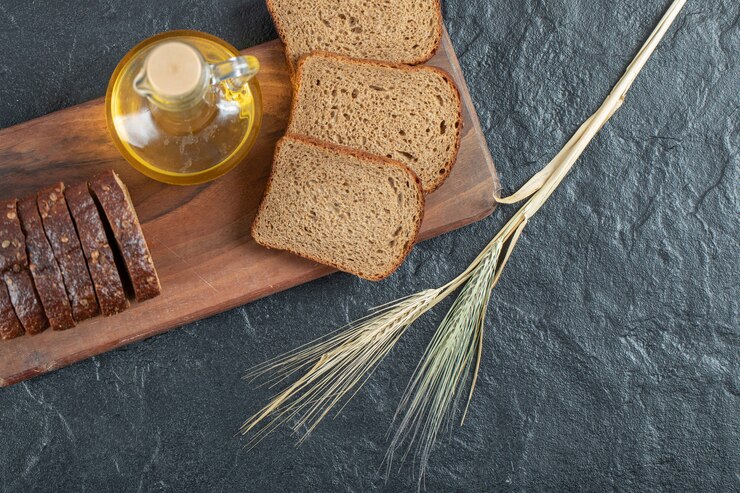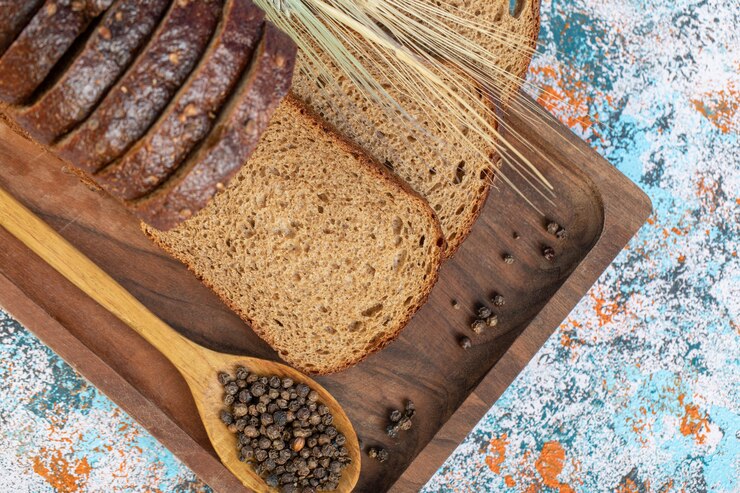Recipe for wheat bread To begin, the bread recipe uses only essential ingredients such as wheat and yeast, combined with milk or water to make the bread. The kneading and yeast proofing, however, remains crucial. After kneading the dough for about 15 minutes, it’s time to shape and tuck it in. There is no quick fix for it; it must be done patiently. furthermore after the dough has been shaped and has risen in the baking tray, brush and wash it with milk. This process aids in the creation of a golden brown, crunchy texture.
How to Make Whole Wheat Bread?
White whole wheat flour or stone-ground whole wheat flour can all be used in this recipe. Unless enough to have milled flour, I prefer and always use stone-ground whole wheat flour.
The technique distinguishes stone-ground whole wheat flour from whole wheat flour, and it may include more fiber and good fats. To create this fantastic, completely delicious handmade bread, gather the following ingredients.
Instant yeast whole wheat flour (although active dry yeast works too), salt, honey, frying oil. This bread dough is quite simple to prepare, and it comes together quickly with only a few ingredients. Because it will rise twice, the period involved is primarily passive.
Warm the water and honey in a large mixing dish or the bowl of your stand mixer. Allow settling for 5 minutes after adding the yeast. Add 4 cups flour, oil, and salt to the yeast mixture and whisk until well combined.
Then, 1/2 cup, add the remaining flour until the dough pulls away from the basin’s edges. Transfer the dough to a lightly floured surface if you’re kneading it by hand. Knead for 6 to 7 minutes with lubricated hands. Switch to the dough hook on a stand mixer and knead the dough for 5 minutes on medium speed.
Ingredients
- 5 1/2 to 6 cups whole wheat flour*
- 2½ cups warm water
- 1½ tablespoons instant yeast (or two packages of active dry yeast)
- 1/4 cup honey
- Two tablespoons oil
- One tablespoon salt
Instructions
- Warm the water and honey in a large mixing dish or the bowl of your stand mixer. Allow settling for 5 minutes after adding the yeast.
- Stir in 4 cups flour, oil, and salt to the yeast mixture until well combined. Then, 1/2 cup, add the remaining flour until the dough pulls away from the basin’s edges.
- Knead the Dough: If kneading by hand, place the bread dough on a lightly floured surface, oil your hands, and knead for 6 to 7 minutes, or until smooth. If using a stand mixer, knead for 4 minutes on medium speed using the dough hook until the dough is smooth. If required, add more flour or water to the dough as needed.
- Place the dough in an oil-coated bowl and let it rise for about 1 hour or until it has doubled in size. Allow the dough to rise for 30 minutes after punching it down.
- Set aside two 9 x 5-inch loaf pans that have been coated. Form the dough into two loaves by dividing them in half. I like to roll a log and then tightly clamp the seam and ends together. Place seam side down in prepared pans, lightly cover, and let rise until the center of the loaf has crowned, about 1-inch over the loaf rim. It takes about 30 minutes.
- Preheat the oven to 350 degrees F in the meantime.
- Place the loaves in the oven after uncovering them. Bake for 35 to 40 minutes, or until a digital thermometer reads 180° to 200°F. If preferred, tent the loaves with foil after 20 minutes to prevent over-browning.
- Remove the bread from the loaf pans and out of the oven. Before slicing, transfer to a cooling rack to cool entirely. Brush it with melted butter as the bread cools for a lovely crust.
What Can I Do to Improve my Whole Wheat Bread?
One approach is to combine whole wheat flour with all-purpose white flour. Even a tiny amount of white flour has enough gluten to improve the dough’s structure. White and whole wheat flour can be swapped one for one, so experiment with the proportions until you find a loaf you enjoy. Honey is used to feed the yeast, tenderize the bread, and add flavor to whole wheat bread.
Agave nectar or granulated sugar could be used instead. Add taste with salt. Butter: You can use unsalted or salted butter.The denser the crumb, the more whole-grain flour you use. Use a little less whole-grain flour if you want a more open crumb.
Is it Necessary to Add More Yeast to Whole Wheat Flour?
This is simple: whole wheat flour has more nutrients than white flour for the yeast to feed on. It is simple to over ferment your dough if you are not prepared. For this, it is accessible to over ferment your dough. A baker must either shorten fermentation times or reduce the dough’s temperature to compensate for this effect. Traditional (red) whole wheat flour produces a lighter-colored, milder-flavored loaf than white whole wheat flour.
There’s no need to adjust your favorite white-flour yeast recipe when whole wheat flour is used up to 50/50 with all-purpose flour; the result should be very close to the original. Feel free to replace half of the all-purpose flour with whole wheat flour in yeast pieces of bread that need to rise without making any other adjustments. Add an extra two teaspoons of liquid per cup of whole wheat flour to produce 100% whole wheat yeast pieces of bread, and let the dough rest for 25 minutes before kneading.
Why is Whole Wheat Bread So Hard?
Whole wheat flour and white flour are separated throughout the milling process, and the whole kernel is ground down into smaller particles at first. You’ll need to grind the kernels until they’re fine enough if you’re producing whole wheat flour. The truth is that getting a whole wheat dough to rise correctly is tough, and the whole wheat you use, the more difficult it becomes.
This problem arises due to the bran and germ found in whole wheat flour. To achieve stronger gluten strands and a lighter crumb, use flour with at least 12 percent protein. Your dough contains an excessive amount of whole-grain flour. The denser the crumb, the more whole-grain flour you use. Use a little less whole-grain flour if you want a more open crumb.
Is it Possible to use Whole Wheat Flour Instead of Bread Flour?
Whole-wheat flour is best used in bread, according to Beranbaum. She has some suggestions for using whole-wheat flour in your pieces of bread: Whole-wheat flour can be substituted for white flour cup for cup. Add five tablespoons of water to each cup you interchange. If you’re working on a recipe that calls for bread flour, but you don’t have any, save yourself a trip to the store and some money by substituting an equal amount of all-purpose flour.
Bread flour and all-purpose flour differ primarily in terms of protein content. Bread flour, available in white and whole wheat variants, has a more excellent protein content than all-purpose flour, ranging between 11 and 13 percent. Because most bread requires more protein to make a lot of gluten, it’s termed “bread flour.”
Conclusion
Whole wheat bread, often known as wholemeal bread, is produced with flour milled from whole or nearly-whole wheat grains. For more information, see whole wheat flour and whole grain, and it’s a specific type of brown bread. Whole grain bread and wholemeal breads are synonyms or near-synonyms for whole-wheat bread outside the United States (e.g., the United Kingdom).
In some parts of the United States, the bread is referred to as wheat bread compared to white bread. Some whole-wheat bread kinds are historically covered with whole or cracked wheat grains, albeit this is ornamental mainly compared to the nutritional content of a high-quality loaf.

